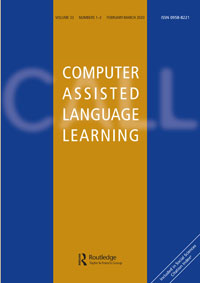【限时资源,期刊全文】Computer Assisted Language Learning《计算机辅助语言学习》2019年论文集-共36篇(侵删)
1822 阅读 22 下载 2020-06-24 18:14:03 上传 31.9 MB
本期推送的是SSCI期刊——Computer Assisted Language Learning《计算机辅助语言学习》2019年论文集、即第32卷第1-8期共36篇论文,其中目录可在正文中查看,全文可以点击文末附件列表下载,下载链接即
Computer Assisted Language Learning《计算机辅助语言学习》2019年论文集-共36篇(侵删)
资料整理:张明辉(微信:zhangxiaojian160408)
(下载链接三天内有效,失效后请联系小编微信索取)

| 卷号 | 期号 | 论文号 | 论文题目 |
| Vol. 32 | Issue 1-2 | Article 01 | The efficiency of prompts when supporting learner use of cognitive and metacognitive strategies |
| Vol. 32 | Issue 1-2 | Article 02 | Simulated speaking environments for language learning: insights from three cases |
| Vol. 32 | Issue 1-2 | Article 03 | Learning French through music: the development of the Bande à Part app |
| Vol. 32 | Issue 1-2 | Article 04 | Self-directed language learning in a mobile-assisted, out-of-class context: do students walk the talk? |
| Vol. 32 | Issue 1-2 | Article 05 | The comparative effects of metalinguistic clue and metalinguistic explanation in computer-mediated form-focused practice: Does prior knowledge matter? |
| Vol. 32 | Issue 1-2 | Article 06 | The effect of four of Richard Mayer’s design principles on vocabulary retention in an Afrikaans computer programme |
| Vol. 32 | Issue 1-2 | Article 07 | The effectiveness of educational technology applications on adult English language learners’ writing quality: a meta-analysis |
| Vol. 32 | Issue 3 | Article 08 | A qualitative study on a situated experience of technology integration: reflections from pre-service teachers and students |
| Vol. 32 | Issue 3 | Article 09 | Comparing teacher’s roles of F2f learning and online learning in a blended English course |
| Vol. 32 | Issue 3 | Article 10 | Bringing L2 learners’ learning preferences in the mediating process through computerized dynamic assessment |
| Vol. 32 | Issue 3 | Article 11 | An English vocabulary learning app with self-regulated learning mechanism to improve learning performance and motivation |
| Vol. 32 | Issue 3 | Article 12 | Impact of flipped classroom on EFL learners' appropriate use of refusal: achievement, participation, perception |
| Vol. 32 | Issue 3 | Article 13 | Toward a neuroscience-informed evaluation of language technology |
| Vol. 32 | Issue 4 | Article 14 | Student satisfaction, learning outcomes, and cognitive loads with a mobile learning platform |
| Vol. 32 | Issue 4 | Article 15 | Teachers’ perception about the contribution of collaborative creation of digital storytelling to the communicative and digital competence in primary education schoolchildren |
| Vol. 32 | Issue 4 | Article 16 | Using an ANN-based computational model to simulate and evaluate Chinese students’ individualized cognitive abilities important in their English acquisition |
| Vol. 32 | Issue 4 | Article 17 | Evaluating English language learners’ conversations: Man vs. Machine |
| Vol. 32 | Issue 4 | Article 18 | Linking text readability and learner proficiency using linguistic complexity feature vector distance |
| Vol. 32 | Issue 4 | Article 19 | A comparative study of lexical word search in an audioconferencing and a videoconferencing condition |
| Vol. 32 | Issue 5-6 | Article 20 | Exploring the differences between low-stakes proctored and unproctored language testing using an Internet-based application |
| Vol. 32 | Issue 5-6 | Article 21 | Using google translate in EFL drafts: a preliminary investigation |
| Vol. 32 | Issue 5-6 | Article 22 | Mediating EFL learners’ academic writing skills in online dynamic assessment using Google Docs |
| Vol. 32 | Issue 5-6 | Article 23 | Moving literature circles into wiki-based environment: the role of online self-regulation in EFL learners’ attitude toward collaborative learning |
| Vol. 32 | Issue 5-6 | Article 24 | The effects of symmetric and asymmetric social networks on second language communication |
| Vol. 32 | Issue 5-6 | Article 25 | Evaluating technology integration in a Vietnamese university language program |
| Vol. 32 | Issue 7 | Article 26 | Teacher training and teachers’ attitudes towards educational technology in the deployment of online English language courses in Jordan |
| Vol. 32 | Issue 7 | Article 27 | Maximizing the potential of captions for primary school ESL students’ comprehension of English-language videos |
| Vol. 32 | Issue 7 | Article 28 | EFL students’ views of willingness to communicate in the extramural digital context |
| Vol. 32 | Issue 7 | Article 29 | Beyond self-directed computer-assisted pronunciation learning: a qualitative investigation of a collaborative approach |
| Vol. 32 | Issue 7 | Article 30 | Collaborative kinesthetic EFL learning with collaborative total physical response |
| Vol. 32 | Issue 7 | Article 31 | Examining EFL learners’ individual antecedents on the adoption of automated writing evaluation in China |
| Vol. 32 | Issue 8 | Article 32 | Corpora and dictionaries as learning aids: inductive versus deductive approaches to constructing vocabulary knowledge |
| Vol. 32 | Issue 8 | Article 33 | Discussing with a computer to practice a foreign language: research synthesis and conceptual framework of dialogue-based CALL |
| Vol. 32 | Issue 8 | Article 34 | Mobile-assisted ESL/EFL vocabulary learning: a systematic review and meta-analysis |
| Vol. 32 | Issue 8 | Article 35 | Students’ reactions to using smartphones and social media for vocabulary feedback |
| Vol. 32 | Issue 8 | Article 36 | Wiki-mediated collaboration and its association with L2 writing development: an exploratory study |
所需积分:0 分
限期开放已结束
表情
图片
附件















